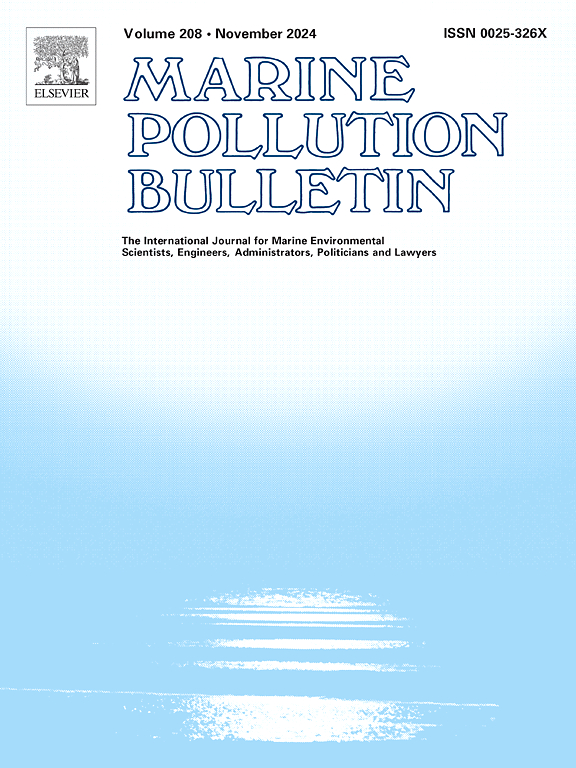Simulation of subsurface mechanical dispersion (SSMD) of oil by a water jet
IF 4.9
3区 环境科学与生态学
Q1 ENVIRONMENTAL SCIENCES
引用次数: 0
Abstract
This study explores the formation of oil droplets (dispersion) using a water jet, labeled herein subsurface mechanical dispersion (SSMD), as an alternative to chemical dispersants for mitigating impacts from subsea oil releases. Utilizing Reynolds-Averaged Navier-Stokes (RANS) and Mixture equations (a multiphase model to calculate the oil volume fraction) within the CFD model Fluent, both small-scale (a 1.0 mm oil orifice diameter and 0.17 mm water jet orifice diameter) and large-scale simulations (oil diameter = 0.5 m and water diameter = 0.05 m) were conducted. Four metrics were used to evaluate the dispersion potential: spatial spread of the oil; the maximum stable diameter of oil droplets, D95; and two metrics that depend on the product of the energy dissipation rate and the holdup (ratio of oil volume to total volume in each cell). The spreading and distribution of oil was quantified in the whole domain of the corresponding simulation. The remaining metrics were evaluated in both the area at the intersection of the oil plume and the water jet, and along the main trajectory of flow. For the small-scale experiment, the simulation results showed good agreement with laboratory observations in terms of oil plume deflection and droplet sizes. At the large-scale, the simulations suggested that SSMD reduced the D95 by 40 % and 80 % for water flow rates that are 17 % and 55 % of the oil rate, respectively. The results suggest that a water jet, at a sufficiently large flowrate, could be a viable technology for initial dispersion of oil spill during response. Further research, including experimental validation and detailed simulations, is needed to ascertain the full potential of SSMD, especially for oil releases containing gas.
水射流对石油地下机械分散的模拟
本研究探讨了使用水射流形成油滴(分散),这里称为地下机械分散(SSMD),作为化学分散剂的替代品,以减轻海底石油释放的影响。利用CFD模型Fluent中的reynolds - average Navier-Stokes (RANS)和Mixture方程(用于计算油体积分数的多相模型),进行了小规模(1.0 mm油孔直径和0.17 mm水孔直径)和大规模(油直径= 0.5 m,水直径= 0.05 m)模拟。利用4个指标评价油的扩散潜力:油的空间扩散;最大稳定油滴直径,D95;两个指标取决于能量耗散率和含油率(每个单元中油体积与总体积的比率)的乘积。在相应模拟的整个域内,对油的扩散和分布进行了量化。其余指标分别在油羽和水射流相交的区域以及沿主要流动轨迹进行了评估。在小规模实验中,模拟结果与实验室观测结果在油羽偏转和液滴大小方面吻合较好。在大尺度上,模拟结果表明,当水流量分别为油流量的17%和55%时,SSMD可将D95降低40%和80%。结果表明,在足够大的流量下,水射流是一种可行的溢油初始分散技术。需要进一步的研究,包括实验验证和详细的模拟,以确定SSMD的全部潜力,特别是对于含气的石油释放。
本文章由计算机程序翻译,如有差异,请以英文原文为准。
求助全文
约1分钟内获得全文
求助全文
来源期刊

Marine pollution bulletin
环境科学-海洋与淡水生物学
CiteScore
10.20
自引率
15.50%
发文量
1077
审稿时长
68 days
期刊介绍:
Marine Pollution Bulletin is concerned with the rational use of maritime and marine resources in estuaries, the seas and oceans, as well as with documenting marine pollution and introducing new forms of measurement and analysis. A wide range of topics are discussed as news, comment, reviews and research reports, not only on effluent disposal and pollution control, but also on the management, economic aspects and protection of the marine environment in general.
 求助内容:
求助内容: 应助结果提醒方式:
应助结果提醒方式:


